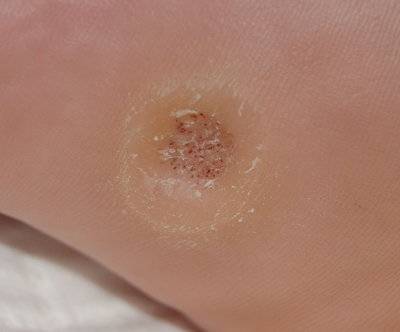Plantar Warts: Symptoms, Causes, and Treatments

Plantar warts are a distinct type of wart that typically grows on the bottom of the feet (often on pressure points like the ball or heel). Plantar warts are caused by HPV (Human Papillomavirus) which usually penetrates the skin through tiny cuts or breaks.
Typically plantar warts are not considered major health concerns; however some people can experience pain from the wart site. This can be particularly irritating as the pressure of standing or walking can magnify the pain. These warts often grow inward below thick calluses (skin layers) making removal difficult.
Common Symptoms of Plantar Warts
- Tiny flesh colored growths under the foot
- Hardened circular skin (the callus) that occurs over a well-defined spot
- Tiny black pinpoints, which are commonly called “wart seeds” but are actually small, clotted blood vessels
- Abrasions that interfere with the normal lines of the feet
- Feelings of pain/tenderness when standing or walking
 (Plantar Wart Closeup via About.com)
(Plantar Wart Closeup via About.com)
What causes plantar warts?
Plantar warts are caused by an infection with the human papillomavirus (HPV) in the outer layer of skin on the sole of your feet. There are more than 100 types of HPV, but only a few types are known to cause warts on your feet. Other types of HPV are more likely to cause warts on other areas of your skin or on mucous membranes.
Who Gets Plantar Warts?
Depending on your immune system you may or may not develop warts from exposure to HPV. Infection that results in warts occurs in an estimated 7-10% of the U.S. population. However plantar warts are most prevalent in children whose developing immune systems are being exposed to the virus for the first time and individuals who have immune system issues.
How Does the HPV virus spread?
The specific strain of HPV that results in plantar warts is not highly contagious. The virus is not easily transmitted through contact and it’s not airborne. To infect its host the virus needs a point of entry to the skin which can include:
- Skin cracks (dry skin)
- Scrapes and cuts
- Macerated skin (skin that’s fragile after prolonged water exposure)
Because the virus thrives in environments that are both warm and moist, common places of transmission include locker rooms, showers, and swimming pools.
How to prevent plantar warts
Unfortunately plantar warts cannot be prevented through currently available HPV vaccines as they are caused by a different strain of HPV.
The only way to prevent plantar warts is to reduce the chances of HPV transmission. Specifically you should reduce any direct contact with surfaces that may be infected. Here are some common prevention tips:
- Do not swim in public pools if you have cracks or lacerations on your feet.
- Avoid sharing socks or shoes with others.
- Always wear socks when trying on shoes or bowling.
- Wear flip-flops in communal showers or locker rooms.
- Never share towels.
Treatment Options
- Salicylic acid: Typically the first line in treatment is a topical medication with salicylic acid as the active ingredient. Over-the-counter treatments exist or medication with higher concentrations of salicylic acid can be prescribed by your dermatologist. Salicylic acid typically resolves about 10-15% of plantar wart cases.
- Cantharidin or “blister beetle”: This is a liquid blistering agent that can be painlessly applied in the office and deactivated several hours later at home with soap and water. Once applied it can cause the individual warts to blister and crust and eventually peel off.
- Liquid nitrogen or cryosurgery: These are common non-surgical treatments which work by freezing the wart causing cellular destruction. While effective, this treatment option most often requires multiple sessions.
- Laser Therapy: Depending on the thickness of the wart and its location on the body, some warts can be treated with a laser called Pulse Dye Laser.
- Intralesional Therapy: These are medications that can be injected directly into persistent warts in the office. One commonly used injectable therapy is “Candin,” a dilute form of the Candida Yeast, which works to boost the body’s immune response to the HPV virus. Bleomycin, a medication that is toxic to the virally infected skin cells, can also be injected.
- Surgical Excision or Laser Surgery: Generally the last treatment option, surgical removal may be necessary for larger plantar warts that do not respond to other treatments.
The most important thing to remember with any treatment is that no treatment is 100% effective. Warts, especially those in thick skinned areas like the soles of the feet and palms of the hands, often require multiple treatment sessions. Some people’s immune systems take longer to respond to the virus and trigger clearing of the wart. The more consistent a patient can be with follow up the faster the wart will respond to therapy.
Are you experiencing issues with plantar warts (or other types of warts)? Visit our wart removal page to schedule an appointment today.

Awesome article.
Thanks for this post 🙂
I’m dealing with a wart on my heel and its very painful. Would insurance cover removing it?
Hi Gene, sorry to hear about that. Plantar warts can definitely be troublesome.
To answer your question, some insurance policies will cover wart removal. However, this depends on your exact plan. Your best bet is to contact your provider directly to confirm exact coverage eligibility and levels. You can also give us a call to setup an appointment or learn more about options.
Thanks again for reading our blog!
— WD Staff
I have a wart between my toes how do I remove it?
Hi Michelle, there are several great in-office treatments that are very effective for plantar wart removal. In particular, cryosurgery and laser deliver instant results. Please contact us today to setup an appointment!
I was diagnose with human papillomavirus 4 years ago and i met a doctor he told me there is no cure and i have be taking some medication the warts multiplied when trying to removed them it got me embarrassed and pains, luckily few weeks ago i was recommend to Dr Abu for a natural treatment after one week treatment i got 100% cure and the warts disappeared, i sheared this post because its part of my life experience, anyone need speedy help about this cure email him via. [email protected] or whatsapp call +2349075383142
Can warts grow inside someone’s stomach or in veins from an open wound?
I have this! Thanks for sharing this! I’m planning on going to the doctor this week because mine got bigger.
Very informative post on plantar warts, its causes, sources and treatment options that may be available for it. Much appreciated!
It’s good to know that hardened circular skin can be a symptom of plantar warts. My brother has been telling me about a circular callus on the arch of his foot. I’ll pass this information along to him so that he can see if it’s a plantar wart that needs to be removed.